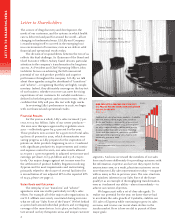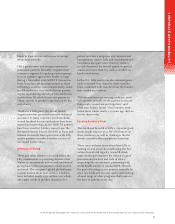Eli Lilly 2006 Annual Report Download - page 6
Download and view the complete annual report
Please find page 6 of the 2006 Eli Lilly annual report below. You can navigate through the pages in the report by either clicking on the pages listed below, or by using the keyword search tool below to find specific information within the annual report.
4
LETTER TO SHAREHOLDERS
extends from early-stage glycemic control to the manage-
ment of complications. We also have an inhaled form of
insulin in late-stage development, in collaboration with
Alkermes. Primary-care doctors who handle an ever-grow-
ing diabetes caseload have told us that they need deep
knowledge of multiple products shared through a single
point of contact—and we are responding. In the U.S., for
example, our Sales Force of the Future now delivers true
portfolio expertise, while allowing our sales representa-
tives to be more productive than they were under the
older system of detailing individual medicines.
Finally, we are centering our diabetes business
squarely on the needs and preferences of patients. For
example, patients clearly are looking for less complicated
and obtrusive ways of managing their medications.
We are responding by launching several new, pen-style
devices for insulin users—based on culturally specifi c
research about patient preferences. Meanwhile, research
and advocacy organizations have called for partnerships
that serve to improve treatment options for patients. Our
global philanthropy responded with dual, $10 million
commitments in 2006 to Indiana University’s research
program on juvenile diabetes and to the International
Diabetes Federation’s BRIDGES program, which translates
clinical fi ndings into real-world treatment applications.
Byetta, our newest therapy, refl ects all of these aspira-
tions. Developed and manufactured as a result of the
Lilly-Amylin partnership, this biotechnology product is
meeting an important need among patients who are not
achieving adequate glucose control but are not ready for
insulin. Three studies now demonstrate that Byetta’s abil-
ity to lower blood-glucose levels is comparable to insulin,
the gold standard. And unlike insulin, which often causes
weight gain, Byetta is associated in every study with
weight loss. You can see one of the thousands of satisfi ed
Byetta patients on the cover of this report.
By the end of 2006, after less than 18 months on the
market, Byetta already ranked fourth in new prescriptions
among all branded products for type 2 diabetes in the U.S.,
and it will begin to launch globally in 2007. To further tailor
Byetta to the needs of specifi c patient groups, we are devel-
oping a long-acting-release formulation of the drug as well.
Pipeline
In 2006, Lilly Research Laboratories (LRL) submitted
Cymbalta for U.S. regulatory approval to treat general-
ized anxiety disorder, and Evista for a new indication
in breast cancer risk reduction. In Japan, Alimta earned
approval—for malignant pleural mesothelioma, in combi-
nation with cisplatin—only six months after submission,
a nearly unprecedented accomplishment in the tough
Japanese regulatory environment. Byetta was approved
in Europe and gained a new indication in the U.S. for use
with thiazolidinediones (TZDs). On the less positive side
in 2006, the U.S. Food and Drug Administration (FDA)
asked for an additional Phase III trial to demonstrate the
effi cacy of Arxxant in treating diabetic retinopathy—a deci-
sion we are appealing as this document goes to press—and
an independent data-monitoring committee concluded that
Lilly’s Phase III trial of enzastaurin for recurrent glioblas-
toma, a form of brain cancer, would be unlikely to achieve
its primary endpoint of improvement in progression-free
survival over an existing chemotherapy.
Our development of enzastaurin for other forms of
cancer is continuing. We also remain very excited about
the prospects of prasugrel, initially for acute coronary
syndrome in patients undergoing percutaneous coronary
intervention (including coronary stenting), which we are
co-developing with Daiichi Sankyo. Our key Phase III
study—a head-to-head superiority trial of prasugrel against
the current standard of care—will be completed in mid-
2007, and success would put us on track for submission
to the FDA by year’s end. We also plan to submit for an
important new line extension in 2007—a long-acting, depot
formulation of Zyprexa for treatment of schizophrenia—as
well as a new indication for Cymbalta in the treatment of
fi bromyalgia. In addition to inhaled insulin, we are also
targeting arzoxifene, a potential next-generation treatment
for osteoporosis, for submission to regulators in 2009.
Transformation: A Company-Wide Imperative
Transformation is a term we do not use lightly. At Lilly,
transformation is motivated by profound changes in the
science of drug discovery and development; heightened
demand for effective medicines brought on by the aging
of populations worldwide; and intense pressures to control
health-care costs. And so: transformation cannot consist of
tinkering at the margins of our current business model but
rather of fi nding wholly new ways to realize and deliver
the full value of our products. Above all, we are convinced
that the Lilly of the future must be a patient-centered enter-
prise, dedicated to improving individual patient outcomes.
Becoming a more patient-centered company will involve
many changes—including greatly improved abilities to tailor
medicines to specifi c patient groups; new connections to our
customers and global partners to capture patient insights
and best practices; and major productivity improvements to
restrain costs and improve our overall effectiveness. No part
of Lilly will be exempt from major change.
In R&D, transformation is gathering momentum,
though the challenge is daunting. For decades, the cost
and time required to bring a new drug to market have
increased inexorably—to upwards of $1 billion and at least
12 years per molecule throughout the industry. Our goal is
not simply to stop but to reverse these trends—even as we
produce new medicines more clearly tailored for effective-
ness in specifi c patient groups.
To those ends, LRL is mapping the critical path for
all phases of development and devising more effi cient
alternatives. In many cases, the result will be a more global
approach. In China, for example, we have had particular
success with partnerships for chemical screening and other



















